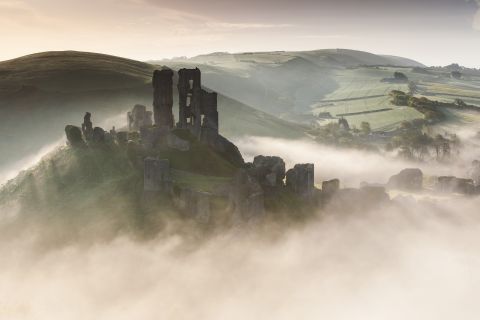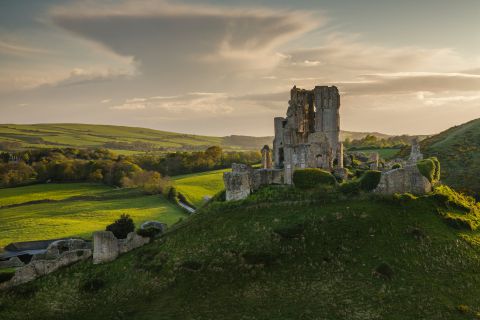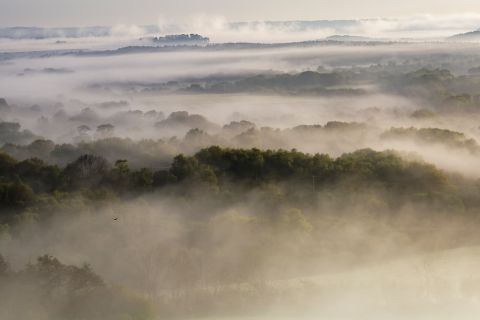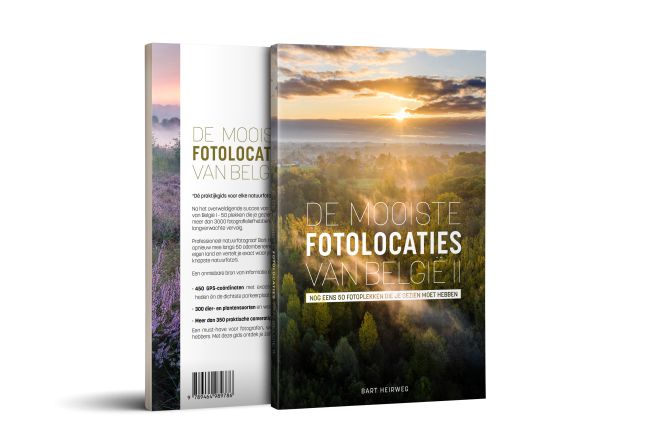Corfe castle

Normally I shun this kind of overly touristic sites, but these ruins promised such a mind-blowing sight that I felt I had to visit them. As a landscape photographer I always prepare my pictures in my head first, before executing them. This time, I hoped to shoot the ruins and its surrounding landscape, captivated in clouds of mist. These moments being very rare, I started by exploring the site with a compass to see where the sun would rise and where I should position myself for the ideal picture. To get the best shot I needed to be there before the first light of day, positioned on the hill looking to the east, to get the perfect light and angle.
Lingering mist
I was on a one week trip to Dorset at the time and it had been very changeable weather for some days. After a very cold and rainy night, I started at 4.30 am and had planned to drive to Studland beach. It being nearly clear sky by the time I got out of my tent, I decided to drive up the hill to check if there was any mist around the castle. To my amazement, the whole valley was blanketed in thick fog. I immediately forgot all about Studland Beach and headed for Corfe Castle. I climbed up the western hill and started leveling my tripod and fitting my camera on it. To avoid any blur due to camera shake, I always use a remote release and the mirror lockup function of my camera. By then, it was 5.30 am and all I could do, was wait for the first light to set in. With my remote in hand, I began to doubt whether it would all turn out ok, as the mist lingered on and concealed the landscape. As beautiful as it was, the mist covered the castle entirely and a clear shot was out of the question. Although I was feeling quite despondent, I decided to walk a bit further up the hill to spy out the land. There, I saw the picture I had made in my head outstretched before me: the ruins lay against the light and rose above the white blanket of fog.

By now, the light had become harder and the contrasts were too high, but with the help of my LEE 0.6 and 0.9 grad ND filters, I was able to keep it under control. I used my hand to keep out the flare and a polarization filter was used to enhance the detail in the sky and give the scene a lightly warmer feeling

As the light kept getting harsher and harsher, my stress level reached its climax. I was so caught up in the moment, trying to make the perfect picture that I forgot to enjoy this remarkable experience. Once I knew that I nailed the picture, I put all my equipment aside and relished the beauty of this extraordinary moment. For me, it was definitely one of the highlights of my photographic career. To illustrate the intense atmosphere of the scene, I wanted to capture both the perfect weather conditions and the medieval look of the ruins in this shot. In that way I tried to convey to the viewer the same mind-blowing effect which I experienced that particular morning in Dorset. It's a sight I will never forget.
Location: Corfe Castle is situated in the south east of Dorset, near Swanage.
How to get there: From Poole take the A35 east, direction Dorchester. At the roundabout take the A351 direction Wareham, then follow the A351 further south direction Corfe Castle. There is a car park near the visiting centre just before you enter the village of Corfe Castle.
What to shoot: The majestic ruins of Corfe Castle either at sunrise or sunset. Views across the Dorset countryside are amazing.
Best time of day: Either at sunrise or sunset. On days with changeable, stormy weather you can shoot all day hoping for a dramatic sky and light. If you are really lucky you might even get a rainbow around the Castle.
What to take: A medium telephoto zoom lens, tripod, polarization and ND grad filters.
Nearest pub: The Castle Inn, 63 East Street, Corfe Castle, Wareham. Tel: 01929 480 208.
Nearest accommodation: Bankes Arms Hotel, East Street, Corfe Castle, Wareham. Tel: 01929 480 206.
Website: www.dorset-hotel.co.uk
Other times of year: The castle can be photographed throughout the year. In spring and autumn chances for mist are higher due to the relatively warm days and cold nights.
Ordnance Survey map: OS Landranger
